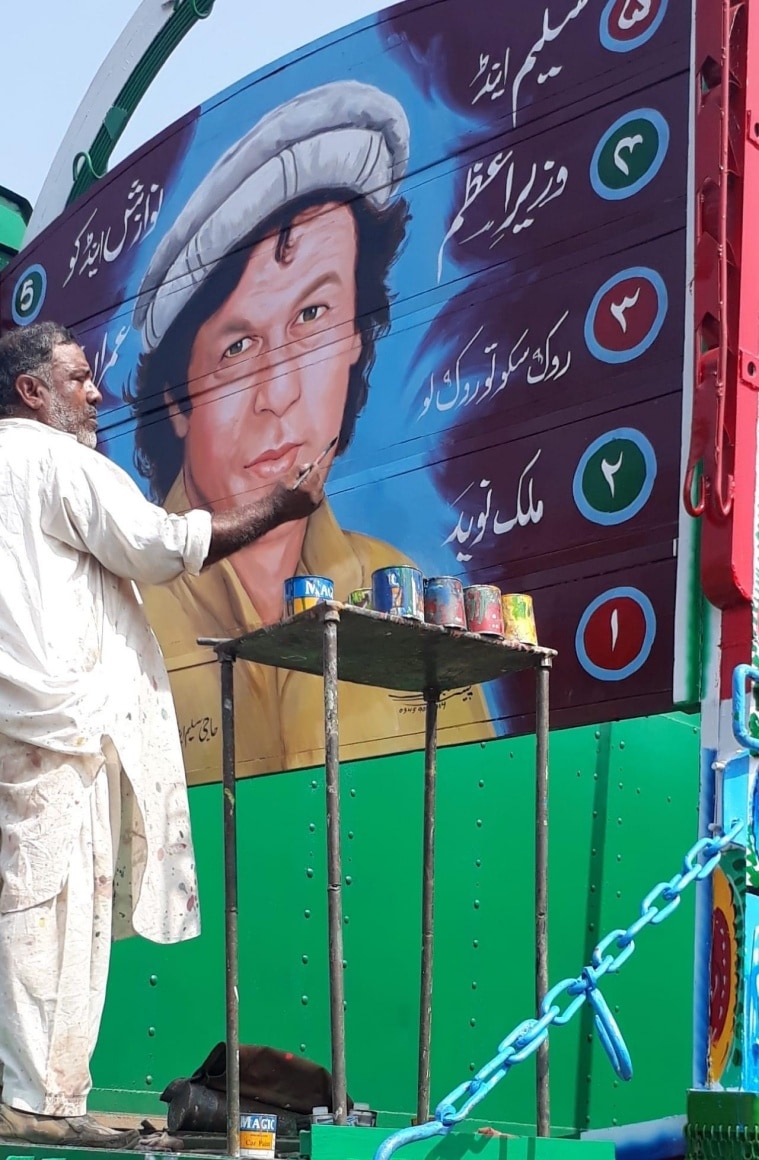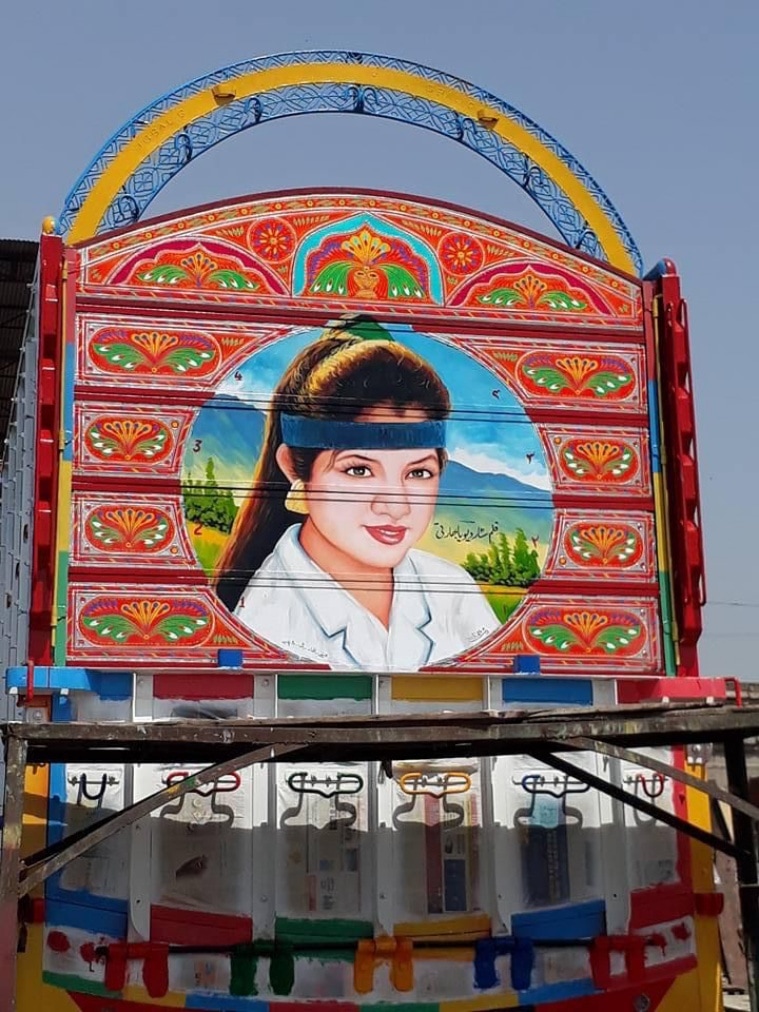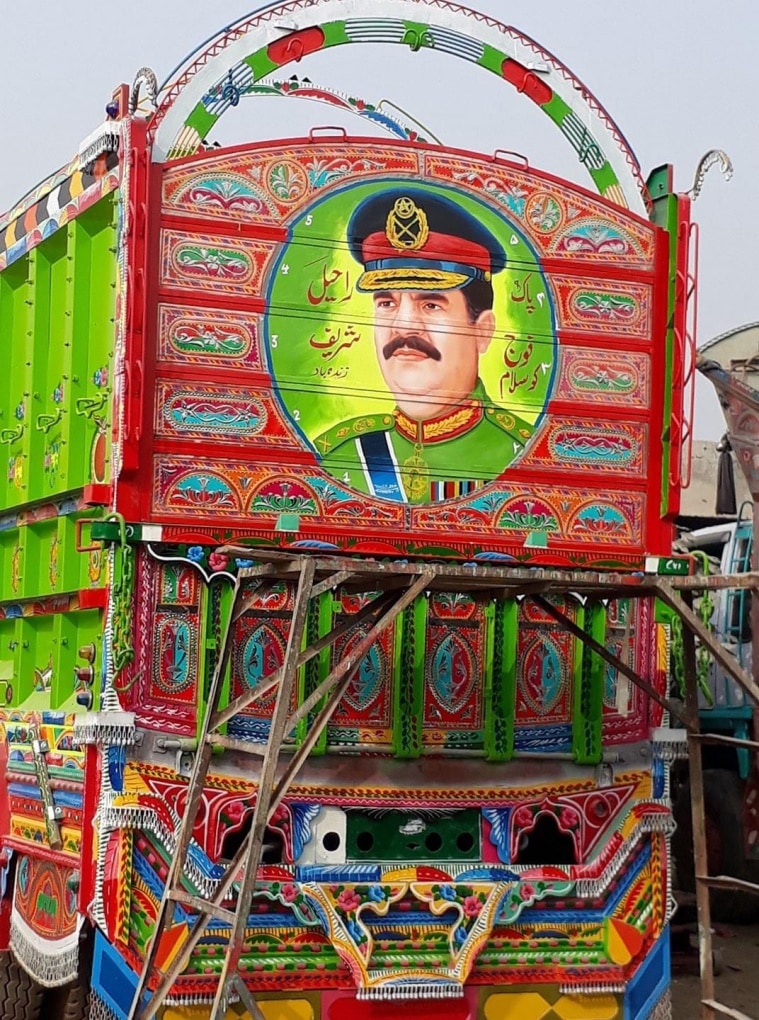Explained: Pakistan’s ‘truck art’ – its ride to recognition and a special tribute to Moosewala
About Moosewala’s popularity in Pakistan, Rizwan Mughal from, son of a truck artist from Rawalpindi, said: “It is because of his humble beginnings and struggle in life that people here connect with him. His songs were close to real life. There is a huge craze for Punjabi songs here.”
A tribute to popular singer-songwriter Sidhu Moosewala in the form of a huge portrait of him painted on the back of a truck in Pakistan has gone viral recently. The truck with Moosewala’s portrait belongs to 30-year-old Shahzad Bhatti from Pakistan’s Punjab province. Why is this viral tribute from across the border a special stop in the long-winding journey of Pakistani truck art?
Why does truck art matter in Pakistan?
The space is special as it is usually reserved for Pakistani national heroes and actors/singers.
 Imran Khan’s portrait being painted on a truck. (Express Photo)Painter Haji Naz (65) from Peshawar, who has spent more than five decades painting portraits on trucks in Pakistan, says that a face that is painted on a truck symbolises people’s immense love for that personality.
Imran Khan’s portrait being painted on a truck. (Express Photo)Painter Haji Naz (65) from Peshawar, who has spent more than five decades painting portraits on trucks in Pakistan, says that a face that is painted on a truck symbolises people’s immense love for that personality.
“In my career, I have painted thousands of trucks. People’s favourites over the years have included General Ayub Khan, General Raheel Sharif, poet Allama Iqbal and most recently Imran Khan too. From the Pakistani music industry, the portraits of singers Atta Ullah Khan Esakhelvi and Nusrat Fateh Ali Khan have been widely painted. Till today, we get the orders for painting General Ayub Khan and even freedom fighter Abdul Ghaffar Khan… Among women, Benazir Bhutto has always been among the favourites,” says Naz.
He adds that some drivers also get portraits of their family members painted which goes on to show how much the space matters to them.
Why is the truck tribute to Moosewala special?
Actors Divya Bharti, Aishwarya Rai and Mamta Kulkarni are among the few Indians whose portraits are seen painted on trucks in Pakistan even now. “Moosewala is probably the first Indian turbaned Sikh who has been given this space but not the first Indian,” says Naz, adding: “I am painting Divya Bharti’s portraits on trucks even now.”
 Divya Bharti’s portrait on a truck. (Express Photo)About Moosewala’s popularity in Pakistan, Rizwan Mughal from, son of a truck artist from Rawalpindi, said: “It is because of his humble beginnings and struggle in life that people here connect with him. His songs were close to real life. There is a huge craze for Punjabi songs here.”
Divya Bharti’s portrait on a truck. (Express Photo)About Moosewala’s popularity in Pakistan, Rizwan Mughal from, son of a truck artist from Rawalpindi, said: “It is because of his humble beginnings and struggle in life that people here connect with him. His songs were close to real life. There is a huge craze for Punjabi songs here.”
Before he was killed, Moosewala had also promised his fans a Pakistan tour with live shows in Lahore and Islamabad “before 2022 ends.”
Where did truck art start, and how did it become popular?
Truck art began in Peshawar and Karachi in the 1950s to cater to demands of truckers who wanted to make their trucks look presentable.
Slowly, this unique blend of colours and murals, accompanied by localised handmade accessories got international fame.
In 2019, UNESCO used this art form to create awareness on girls’ education in Kohistan district of Pakistan.
Ejaz Ullah Mughal, whose father late Habeeb was among the first truck artists in Rawalpindi in 1956, remembers how back then officials from the Pakistan National Council of Arts (PNCA) “used to mock” truck art.
 Benazir Bhutto’s portrait on a truck. (Express Photo)“It was around 1952 when some local artists started painting trucks, number plates and doing wood carving work to beautify them. It was a localized art form which travelled the world as it got popular among the foreigners who would come to Pakistan to get their vintage vehicles decorated. The manufacturing of Bedford trucks was stopped way back by its UK company, but in Pakistan, they still work and look brand new because of the truck art. Truck artists are mostly self-taught without fancy degrees,” says Mughal.
Benazir Bhutto’s portrait on a truck. (Express Photo)“It was around 1952 when some local artists started painting trucks, number plates and doing wood carving work to beautify them. It was a localized art form which travelled the world as it got popular among the foreigners who would come to Pakistan to get their vintage vehicles decorated. The manufacturing of Bedford trucks was stopped way back by its UK company, but in Pakistan, they still work and look brand new because of the truck art. Truck artists are mostly self-taught without fancy degrees,” says Mughal.
People are known to spend Rs 1 lakh to Rs 20 lakh in Pakistan currency to get their trucks painted even now. But the art form is dying out slowly.

General Raheel Sharif’s portrait on a truck. (Express Photo)“Just a few of them (truck artists) are now left in Peshawar, Rawalpindi and Karachi who know original work,” Mughal adds.
Tariq Ustaad, a truck artist from Rawalpindi who has been in the profession since 1971, says that truck art became exquisite and more intricate over time.
“It was very simple when we had started. Earlier, we used to complete five trucks in a day, and now one truck in five days. There were times when some drivers even got truck’s keys made in gold,” said Ustaad.
Niaz Gul, a transporter from Peshawar, said that earlier there was even a trend to decorate buses but it died with time.
Bahaar Ali, another truck artist, says: “It is just in some pockets of Punjab and Khyber Pakhtunkhwa (KPK) in Pakistan that truck art is still visible because people here are fond of driving trucks. Efforts are required to preserve this dying heritage. Hamara kaam to har truck ko dulhan ki tarah sajaana hai taaki sab nazrein ussi par tiki rahein (Our work is to decorate each truck like a bride, so that people cannot take their eyes off it).”



[…] Also Read : Explained Pakistans truck art its ride to recognition and a special tribute to Moosewala […]